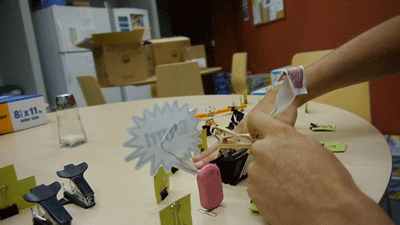Little Corporate Orc Wars: The Play-by-Play

Little Orc Wars is a war game created by Skirmisher Publishing that calls for the use of live siege weapon fire and has the flexibility to accommodate any miniatures at hand – even homemade ones. A co-worker (Sam) and I decided to test that aspect of the game by building our own miniatures using only the materials available in our office. Thus “Little Corporate Orc Wars” is born, a game for long days at the office that need a little bit of fun (but be ready to explain to coworkers what the hell you’re doing)!
The Combatants
Sam is lucky enough to have a wooden carving of a man on a surf board that, by the rules of Little Orc Wars, counts as a giant – and at five inches tall it is a powerful, five melee dice one at that – and can hurl four boulders a turn! He chose to augment his already formidable force with a four-inch-tall, folded-paper ogre, five paper Thark cavalry on Thoat-back, and ten paper Orc swordsmen. As his siege weapon, Sam built himself a pencil ballista. Sam’s force was worth a respectable 30 points.
I didn’t have any powerful, oversized units, so to counter Sam I went for a swarm approach. My army was made up of mostly green post-it-note Goblins, an inferior troop, but cheaper and so good for swarm tactics. A good half of my Goblins were equipped with ranged weapons as well, a decision that proved advantageous later in the game. I also had a pair of post-it-note Goblin Worg riders, and five warbeasts to go with them – of course the warbeasts were staple removers. My army was led by a hobgoblin chieftain made from an eraser and held up by a pair of paperclips. To account for Sam’s giant and ballista I needed to build two siege weapons, and so I designed myself a catapult and my own pencil ballista.
The Battlefield
The field of battle was made of two break-room tables pushed together, with the top of a printer paper box serving as a bridge. These were relatively close quarters for our over-engineered siege weapons, so many shots were wasted going over the back of the table until we dialed in our range. The bridge provided very good cover from ballista fire, but its light weight made it dangerous to cross, as direct ballista fire would knock over any units on top of it.
Round 1

In the opening salvo Sam misses with his ballista, and then accidentally kills one of his own orcs with his giant – not an auspicious start! In my return volley I manage to kill both his Ogre with my ballista, and several of his Thark cavalry with my catapult.


Round 2

In round 2 Sam manages to figure out the catapult to devastating effect! I am not as successful with my return fire and, having lost many of my goblins, I move out with my warbeasts and ranged units hoping to find victory in melee.
Round 3
In round 3 we have our first melee, and despite my one melee die advantage we both ended up with the same dice worth of troops.
Rounds 4-10
I am quickly reduced to eight goblins, only enough to operate one of my siege engines, but in return I am able to kill Sam’s giant and kill one of the last four orcs operating his ballista – no more siege weapons for Sam! Sam puts his units into motion, and charges at my back line with his only remaining units (valued at five melee dice). Unfortunately my eight goblins are only worth half a point each, Sam is winning.
I chase Sam’s Thark cavalry around with my five remaining ranged units, but his luck stays strong and my inferior troops are not able to get a kill. I give up on trying to win through conventional combat and make a break back for my siege weapons Sam, in the meantime, advances his remaining forces over the bridge – leaving them vulnerable. I am not close enough to the catapult with my goblins to fire it, the ballista is my only option and I only get one shot.
The pencil flies and I get a lucky bounce, it takes out all four of Sam’s units and gives me the win.



